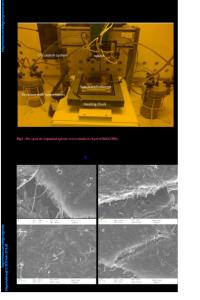Generation three-dimensional nitrogen-doped graphene frameworks as advanced electrode for supercapacitors
- PDF / 641,603 Bytes
- 11 Pages / 584.957 x 782.986 pts Page_size
- 98 Downloads / 992 Views
Min Zhang and Faliang Cheng Guangdong Engineering and Technology Research Center for Advanced Nanomaterials, Dongguan University of Technology, Dongguan, Guangdong 523808, China (Received 3 August 2017; accepted 30 August 2017)
Three-dimensional nitrogen-doped graphene frameworks (3DNGFs) hold great promise in the application of supercapacitors for the advantages of superior conductivity, well-connected porous structure, and additional N-containing active sites for charge storage. Nevertheless, the developed techniques for preparing 3DNGFs always suffer from the drawbacks of high cost or complex processes for large-scale application. Herein, a new and cost-effective method has been developed to massively prepare monolithic 3DNGFs by a simple and scalable electrochemical oxidation process. Benefiting from the enhanced electrical conductivity, the increase in the pore volume for fast diffusion increased the electrode–electrolyte contact area and additional active sites resulting from the incorporation of nitrogen species, the 3DNGFs showed a high specific capacitance of 2250.3 mF/cm2 at 4 mA/cm2, with good rate capability. Furthermore, this 3DNGFs electrode also owns an excellent long-term cycling stability that can retain more than 97.5% of its original capacitance after 10,000 cycles. I. INTRODUCTION
It has been increasingly urgent to develop clean renewable energies and efficient energy storage devices due to the shortage of conventional fossil fuels and environmental pollution. Electrochemical capacitors (also known as supercapacitors or ultracapacitors), are a kind of important energy-storage devices that exhibit much higher power densities, faster charge/discharge rates, better reversibility, and super-long cycle life, when compared with other energy storage systems such as batteries.1–5 Supercapacitors (SCs) have attracted numerous attentions as a priority candidate of energy storage devices. The performance of SCs is closely related to the properties of the electrode materials. Several kinds of materials have been used as electrodes for SCs, such as carbon-based materials,6–10 transition metal oxides (MnO2, RuO2, Co3O4, and NiCo2O4),4,5 hydroxides and conducting polymers (polyaniline, polypyrrole, and polythiophene), and their composites.8 Among these materials, carbon-based materials such as activated carbon, carbon nanotubes, carbon fibers, and graphene et al. have been widely used as active materials or frameworks for SCs, for their notable features of inexpensive, high surface area, good conductivity, and Contributing Editor: Yat Li a) Address all correspondence to this author. e-mail: [email protected] DOI: 10.1557/jmr.2017.387
outstanding chemical stability.6–10 Among various carbon-based materials, three-dimension graphene-based framework (3DGF) materials including aerosol,11–14 hydrosol,15–17 and foam18–21 have been regarded as emerging materials for SCs due to their unique characteristics such as outstanding electrical properties, ultrahigh theoretical specific surface area, and a well-interconnecte
Data Loading...











